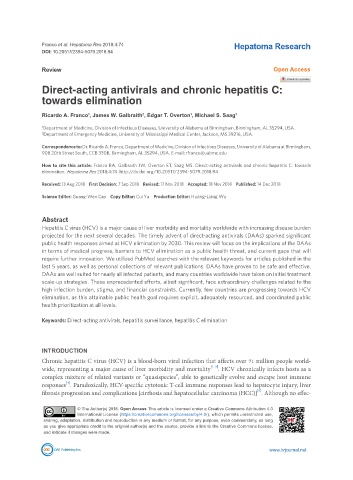Page 827 - Read Online
P. 827
Franco et al. Hepatoma Res 2018;4:74 Hepatoma Research
DOI: 10.20517/2394-5079.2018.94
Review Open Access
Direct-acting antivirals and chronic hepatitis C:
towards elimination
2
1
1
Ricardo A. Franco , James W. Galbraith , Edgar T. Overton , Michael S. Saag 1
1 Department of Medicine, Division of Infectious Diseases, University of Alabama at Birmingham, Birmingham, AL 35294, USA.
2 Department of Emergency Medicine, University of Mississippi Medical Center, Jackson, MS 39216, USA.
Correspondence to: Dr. Ricardo A. Franco, Department of Medicine, Division of Infectious Diseases, University of Alabama at Birmingham,
908 20th Street South, CCB 330B, Birmingham, AL 35294, USA. E-mail: rfranco@uabmc.edu
How to cite this article: Franco RA, Galbraith JW, Overton ET, Saag MS. Direct-acting antivirals and chronic hepatitis C: towards
elimination. Hepatoma Res 2018;4:74. http://dx.doi.org/10.20517/2394-5079.2018.94
Received: 13 Aug 2018 First Decision: 7 Sep 2018 Revised: 17 Nov 2018 Accepted: 18 Nov 2018 Published: 14 Dec 2018
Science Editor: Guang-Wen Cao Copy Editor: Cui Yu Production Editor: Huang-Liang Wu
Abstract
Hepatitis C virus (HCV) is a major cause of liver morbidity and mortality worldwide with increasing disease burden
projected for the next several decades. The timely advent of direct-acting antivirals (DAAs) sparked significant
public health responses aimed at HCV elimination by 2030. This review will focus on the implications of the DAAs
in terms of medical progress, barriers to HCV elimination as a public health threat, and current gaps that will
require further innovation. We utilized PubMed searches with the relevant keywords for articles published in the
last 5 years, as well as personal collections of relevant publications. DAAs have proven to be safe and effective.
DAAs are well suited for nearly all infected patients, and many countries worldwide have taken on initial treatment
scale-up strategies. These unprecedented efforts, albeit significant, face extraordinary challenges related to the
high infection burden, stigma, and financial constraints. Currently, few countries are progressing towards HCV
elimination, as this attainable public health goal requires explicit, adequately resourced, and coordinated public
health prioritization at all levels.
Keywords: Direct-acting antivirals, hepatitis surveillance, hepatitis C elimination
INTRODUCTION
Chronic hepatitis C virus (HCV) is a blood-born viral infection that affects over 71 million people world-
wide, representing a major cause of liver morbidity and mortality . HCV chronically infects hosts as a
[1-3]
complex mixture of related variants or “quasispecies”, able to genetically evolve and escape host immune
[4]
responses . Paradoxically, HCV-specific cytotoxic T-cell immune responses lead to hepatocyte injury, liver
[5]
fibrosis progression and complications [cirrhosis and hepatocellular carcinoma (HCC)] . Although no effec-
© The Author(s) 2018. Open Access This article is licensed under a Creative Commons Attribution 4.0
International License (https://creativecommons.org/licenses/by/4.0/), which permits unrestricted use,
sharing, adaptation, distribution and reproduction in any medium or format, for any purpose, even commercially, as long
as you give appropriate credit to the original author(s) and the source, provide a link to the Creative Commons license,
and indicate if changes were made.
www.hrjournal.net

